 |
 |
 |
| |
Efficacy of Entecavir and Lamivudine in Chronic Hepatitis B Patients with Advanced Liver Fibrosis/Cirrhosis
|
| |
| |
Reported by Jules Levin
EASL, April 11-15, 2007
Barcelona, Spain
H. Simsek1, E. Schiff2, Z. Goodman3, H. Brett-Smith4, K. Klesczewski4, B. Kreter4
1Department of Internal Medicine, Hacettepe University Medical School, Ankara, Turkey; 2Center for Liver Diseases, University of Miami School of Medicine, Miami, USA;
3Department of Hepatic and Gastrointestinal Pathology, Armed Forces Institute of Pathology, Washington, DC, USA; 4Bristol-Myers Squibb Company, Wallingford, CT, USA
AUTHOR CONCLUSIONS
Patients with advanced liver fibrosis are at increased risk for disease progression.
Responses among patients with advanced liver fibrosis were consistent with histologic, virologic and biochemical endpoints observed in the overall study population.
The observed proportions of patients achieving histologic improvement, HBV DNA < 300 copies/mL and ALT normalization were higher among ETV-treated patients in both, the advanced liver fibrosis subgroup and the overall study population.
Rates of HBe seroconversion among nucleoside-naive HBeAg(+) patients with advanced liver fibrosis were 33% for ETV-treated patients and 30% for LVD-treated patients.
Rates of HBe seroconversion among lamivudine-refractory HBeAg(+) patients with advanced liver fibrosis were 4% for ETV-treated patients and 10% for LVD-treated patients.
The safety profiles of ETV and LVD were comparable among patients with advanced liver fibrosis/cirrhosis.
Entecavir provides an effective treatment option for patients with advanced liver fibrosis due to chronic hepatitis B.
Introduction
Fibrosis and cirrhosis are well-recognized complications of chronic hepatitis B (CHB) infection
Until recently, liver fibrosis and cirrhosis have generally been considered to be irreversible. However, advances in the treatment of liver diseases have shown that therapeutic interventions have been associated with histologic improvement, including regression of fibrosis1,2
Recent studies have shown that antiviral therapy can reduce disease progression to hepatic decompensation and hepatocellular carcinoma in CHB patients with advanced fibrosis/cirrhosis3,4
Entecavir (ETV) is an antiviral approved for treatment of CHB. Several studies have shown ETV to be superior to lamivudine (LVD) in improving histology, virologic and biochemical endpoints in compensated, cirrhotic patients with CHB5-7
Objective
In the Phase III ETV studies, a subset of patients had advanced liver fibrosis/cirrhosis at baseline (Ishak score of 4-6).
This was a descriptive subgroup analysis to assess Week 48 treatment responses in patients with biopsy-proven advanced liver fibrosis/cirrhosis at baseline.
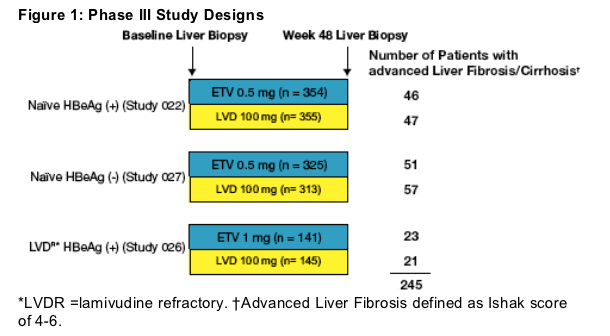
Methods
Selected Criteria for Enrollment in Phase III ETV Clinical Trials
- HBV DNA ≥3 MEq/mL (HBeAg+) or ≥0.7 MEq/mL (HBeAg-) by bDNA assay
- ALT 1.3-10 x ULN
- Compensated liver function
Total serum bilirubin ≦2.5 mg/dL
Prothrombin time ≦3 sec or INR ≦1.5
Serum albumin ≥3.0 g/dL
No history of variceal bleed or hepatic encephalopathy
- Alpha-fetoprotein ≦100 ng/mL
- No HCV, HDV, HIV coinfection
Key Study Endpoints
Primary
- Histologic Improvement: ≥2 point improvement in Knodell Necroinflammatory Score with no worsening of Knodell fibrosis score at Week 48
Secondary
- Proportion of patients with HBV DNA <300 copies/mL by Roche COBAS Amplicor
PCR
- ALT normalization (≦1.0 x ULN)
- HBe seroconversion
RESULTS
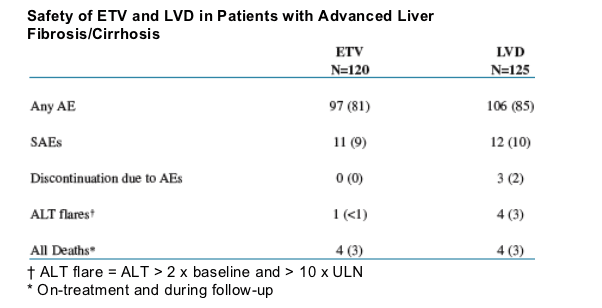
The safety profiles of ETV and LVD were comparable among patients with
advanced liver fibrosis/cirrhosis.
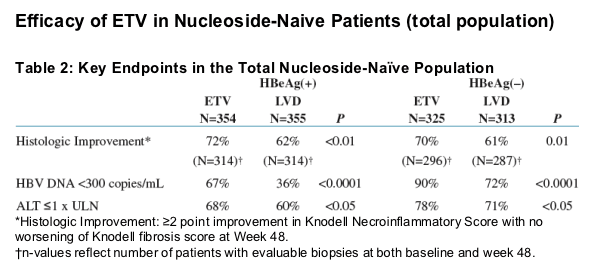
Significantly greater numbers of ETV- vs LVD-treated patients achieved histologic improvement among HBeAg(+) and (-) nucleoside-naive patients
Significantly greater numbers of ETV- vs LVD-treated patients achieved HBV DNA<300 copies/mL among HBeAg(+) and (-) nucleoside-naive patients
Significantly greater numbers of ETV- vs LVD-treated patients achieved ALT ≦1 x ULN among HBeAg(+) and HBeAg(-) nucleoside-naive patients
Efficacy of ETV in Nucleoside-Naive Patients with Advanced LiverFibrosis/Cirrhosis
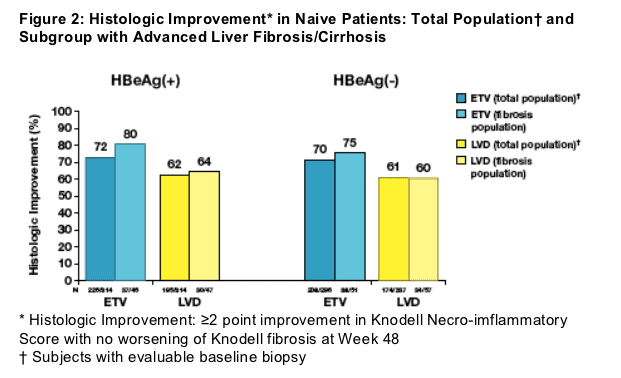
Rates of histologic improvement were consistent between the fibrotic subgroup and the total nucleoside-naive population (Figure 2).
The observed proportion of patients who achieved histologic improvement was higher for ETV-treated patients in the total population (72% ETV, 62% LVD HBeAg+; 70% ETV, 61% LVD HBeAg-) and among patients with advanced liver fibrosis (80% ETV, 64% LVD HBeAg+; 75% ETV, 60% LVD HBeAg-).
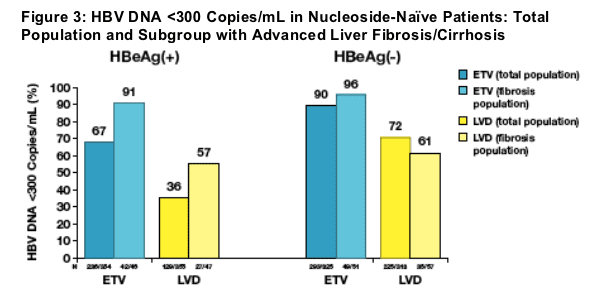
HBV DNA responses in the fibrotic subgroup were consistent with the total nucleoside-naive population (Figure 3).
The observed proportion of patients who achieved HBV DNA <300 copies/mL was higher for ETV-treated patients in the total population and among patients with advanced liver fibrosis. (In the fibrosis population ETV % <300 copies/mL HBV DNA increased from 67% to 91% in HBeAg and LVD % <300 c/ml HBV DNA increased from 36% to 57%; for HBeAg- fibrotics ETV % <300 c/ml HBV DNA increased from 90% to 96% and LVD % <300 c/ml HBV DNA decreased from 72% to 61%).
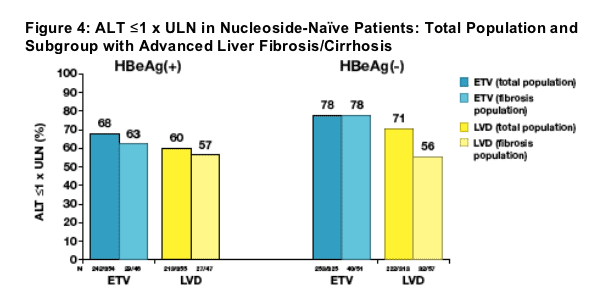
Rates of ALT normalization in the fibrotic subgroup were consistent with the total nucleoside-naive population (Figure 4)
The observed proportion of patients who achieved ALT normalization was higher for ETV-treated patients in the total population and among patients with advanced liver fibrosis
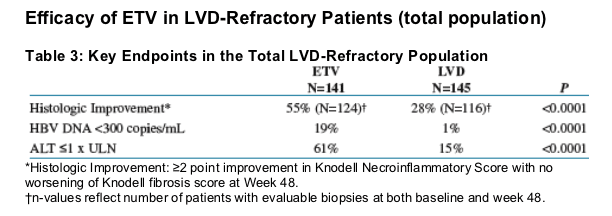
Significantly greater numbers of ETV- vs LVD-treated LVD-refractory patients achieved histologic improvement (55% vs 28%) , HBV DNA <300 copies/mL (19% vs 1%) and ALT ≦ 1 x ULN 961% vs 15%).
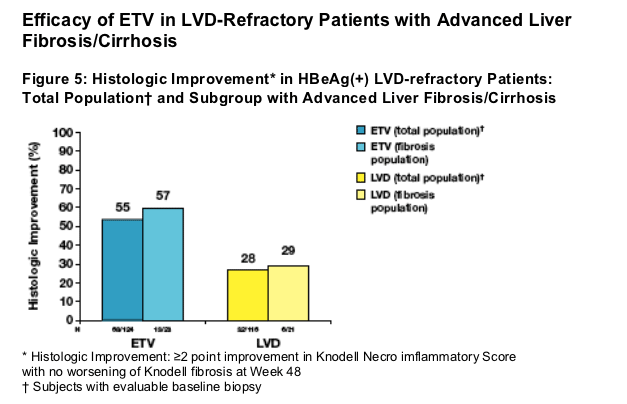
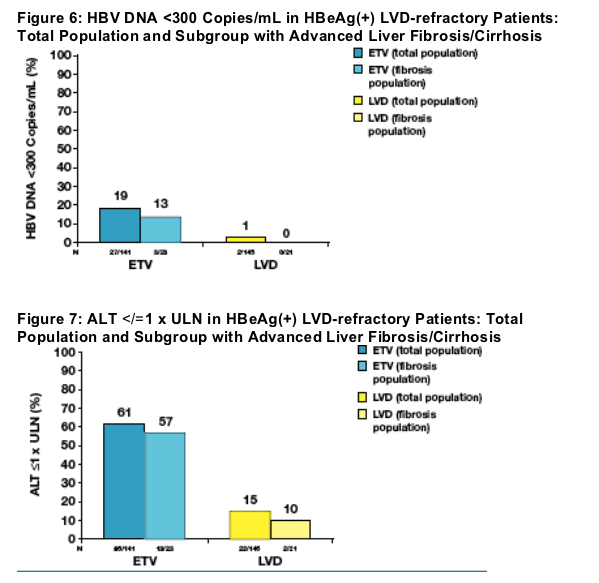
Rates of histologic improvement, HBV DNA response, and ALT normalization were consistent between the fibrotic subgroup and the total LVD-refractory population (Figures 5, 6, and 7)
The observed proportion of patients who achieved histologic improvement, HBV DNA <300 copies/mL, and ALT normalization was higher for ETV treated patients in the total population and among patients with advanced liver fibrosis. (% <300 c/ml was 13% for ETV in HBeAg+ fibrotics vs 0% for LVD; % ALT
References
1. Kaplan MM, et al. Ann Intern Med. 1997;126:981-985
2. Poynard T, et al. Hepatology. 2000;32:1131-1137
3. Dienstag JL, et al. Gastroenterology. 2003;124:105-117
4. Liaw Y-F, et al. N Engl J Med. 2004;351:1521-1531
5. Chang TT, et al. New Engl J Med 2006;354:1001-1010
6. Lai CL, et al. New Engl J Med 2006;354:1011-1020
7. Sherman M, et al. Gastroenterology. 2006;130:2039-2049
|
| |
|
 |
 |
|
|